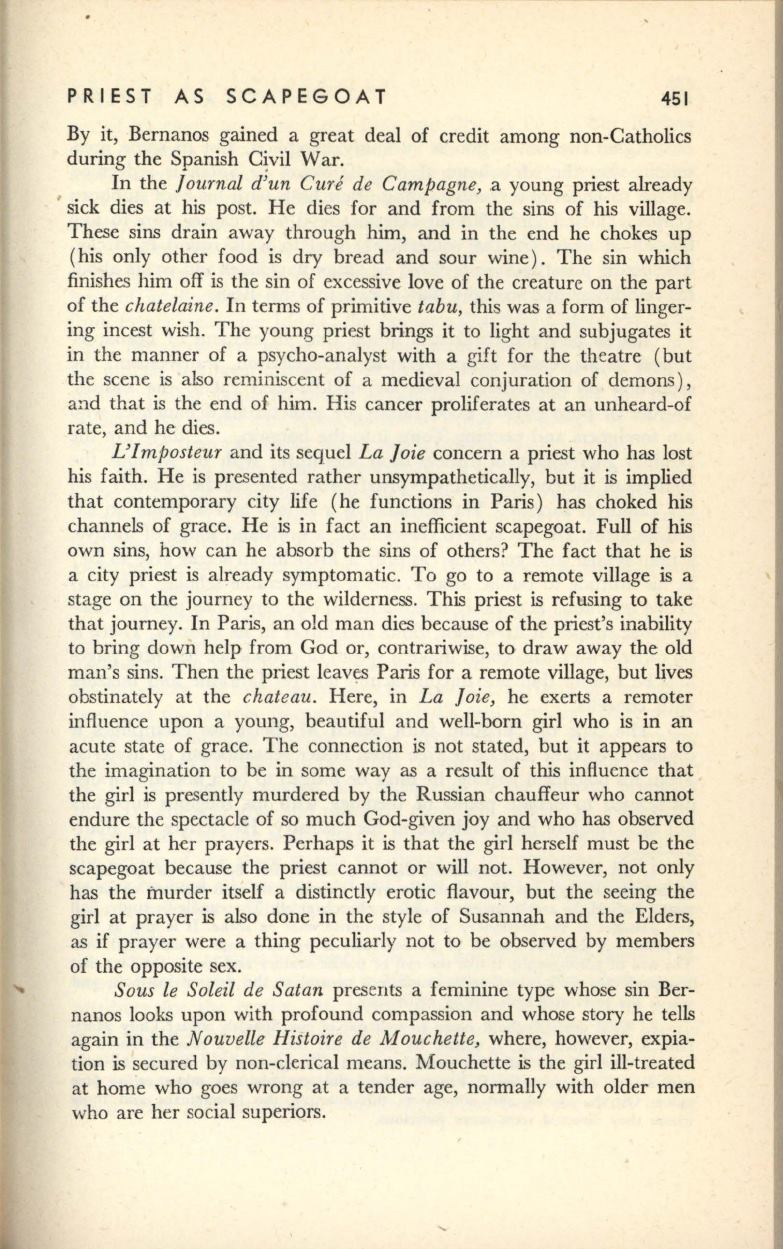
PRIEST AS SCAPEGOAT
451
By it, Bernanos gained a great deal of credit among non-Catholics
during the Spanish qvil War.
In the
journal d)un Cure de Campagne)
a young priest already
' sick dies at his post. He dies for and from the sins of his village.
These sins drain away through him, and in the end he chokes up
(his only other food is dry bread and sour wine). The sin which
finishes him off is the sin of excessive love of the creature on the part
of the
chatelaine.
In terms of primitive
tabu,
this was a form of linger–
ing incest wish. The young priest brings it to light and subjugates it
in the manner of a psycho-analyst with a gift for the theatre (but
the scene is also reminiscent of a medieval conjuration of demons),
and that is the end of him. His cancer proliferates at an unheard-of
rate, and he dies.
VImposteur
and its sequel
La ] oie
concern a priest who has lost
his faith. He is presented rather unsympathetically, but it is implied
that contemporary city life (he functions
in
Paris) has choked his
channels of grace. He is in fact an inefficient scapegoat. Full of his
own sins, how can he absorb the sins of others? The fact that he is
a city priest is already symptomatic. To go to a remote village is a
stage on the journey to the wilderness. This priest is refusing to take
that journey. In Paris, an old man dies because of the priest's inability
to bring down help from God or, contrariwise, to draw away the old
man's sins. Then the priest
leav~
Paris for a remote village, but lives
obstinately at the
chateau.
Here, in
La ]oieJ
he exerts a remoter
influence upon a young, beautiful and well-born girl who is in an
acute state of grace. The connection is not stated, but it appears to
the imagination to be in some way as a result of this influence that
the girl is presently murdered by the Russian chauffeur who cannot
endure the spectacle of so much God-given joy and who has observed
the girl at her prayers. Perhaps it is that the girl herself must be the
scapegoat because the priest cannot or will not. However, not only
has the murder itself a distinctly erotic flavour, but the seeing the
girl at prayer is also done in the style of Susannah and the Elders,
as if prayer were a thing peculiarly not to be observed by members
of the opposite sex.
Sous le Soleil de Satan
presents a feminine type whose sin Ber–
nanos looks upon with profound compassion and whose story he tells
again in the
Nouvelle Histoire de MouchetteJ
where, however, expia–
tion is secured by non-clerical means. }vfouchette is the girl ill-treated
at home who goes wrong at a tender age, normally with older men
who are her social superiors.


